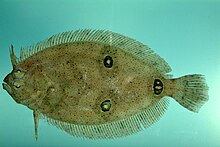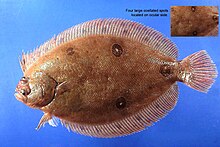
Citharichthys is a genus of flatfish in the large-tooth flounder family, Paralichthyidae. They have both eyes on the left sides of their heads. They are native to the oceans around the Americas, with a single species, C. stampflii off the West African coast. Most are found in relatively shallow depths, but the genus also includes species found in deep water and species that enter fresh water.
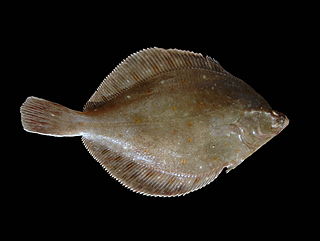
Pleuronectidae, also known as righteye flounders, are a family of flounders. They are called "righteye flounders" because most species lie on the sea bottom on their left sides, with both eyes on their right sides. The Paralichthyidae are the opposite, with their eyes on the left side. A small number of species in Pleuronectidae can also have their eyes on the left side, notably the members of the genus Platichthys.
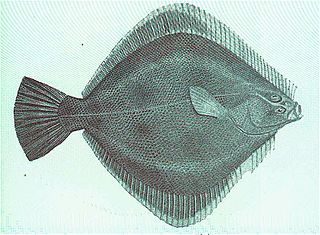
The New Zealand sand flounder is a righteye flounder of the genus Rhombosolea, found around New Zealand in shallow waters down to depths of 100 m.

Paralichthys adspersus, the fine flounder, is a species of large-tooth flounder native to the eastern Pacific Ocean, along the continental shelf from the coast of Ecuador in the north to the coast of Peru in the south.

Apogon is a large genus of fish in the family Apogonidae, the cardinalfishes. They are among the most common fish on coral reefs. Over 200 species have been classified in genus Apogon as members of several subgenera. Some of these subgenera, such as Ostorhinchus, have been elevated to genus status, leaving just over 50 species in the genus.

The yellowtail flounder, also known as the rusty dab, is a species of flatfish in the family Pleuronectidae. Reaching 56 cm (22 in) in length, it has reddish brown upperparts, pale underparts and yellow fins. Both its eyes are on the right (upper) side of its body. Found in the western North Atlantic, it has been fished commercially by North American fisheries for food. A victim of overfishing, the yellowtail flounder is categorized as "Vulnerable" by the International Union for Conservation of Nature.
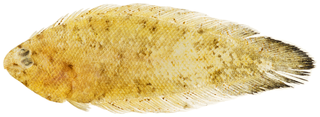
Symphurus is a genus of fish in the family Cynoglossidae found in the Atlantic, Indian and Pacific Ocean. Most species mainly occur in relatively shallow water, including estuaries. Some species are also found in deeper water, including S. thermophilus that lives at hydrothermal vents. These species are distinguished by merged dorsal, caudal and anal fins, the absence of a lateral line and pectoral fins, and the presence of only one pelvic fin. They are sinistral flatfishes, meaning that as adults, their crania are asymmetrical, with both eyes on the left side. The largest species grows to about 32 cm (1 ft) long.

Limanda is a genus of righteye flounders native to the northern Atlantic and Pacific oceans.

Pleuronichthys is a genus of fish in the family Pleuronectidae found in the Pacific Ocean.

Bothus is a genus of flatfish in the family Bothidae from the Pacific, Indian and Atlantic Oceans. Some species in this genus have spots consisting of blue rings.

Chascanopsetta is a genus of flatfish in the family Bothidae found in deeper parts of the Pacific and Indian Oceans with a single species, C. lugubris also occurring in the Atlantic Ocean. It contains nine member species.

The scaldfishes comprise a genus, Arnoglossus, of lefteye flounders. They are found in the Pacific, Indian and Atlantic Oceans, including the Mediterranean and Black Sea. They are entirely absent from most of the Americas; the only exceptions are A. coeruleosticta and A. multirastris found off Chile. The genus include both species found in shallow and deeper water. The largest species reaches 28 cm (11 in).

Engyprosopon is a genus of small lefteye flounders. They are found in the Indo-Pacific, ranging from shallow coastal waters to depths in excess of 400 m (1,300 ft).

Trichopsetta is a genus of small lefteye flounders native to the western Atlantic Ocean.

Etropus is a genus of large-tooth flounders native to the coastal waters of the Americas.

Hippoglossina is a genus of large-tooth flounders native to the coastal Pacific waters of the Americas. A single species, H. oblonga is found along the Atlantic coast of United States and Canada, but it is frequently placed in Paralichthys instead of Hippoglossina.

Paralichthys is a genus of large-tooth flounders. Most species are native to the coastal waters of the Americas, but P. olivaceus is from northeast Asia. The largest species reaches about 1.5 m (5 ft) in length.

Syacium is a genus of large-tooth flounders found in the Atlantic and Pacific Oceans. With the exception of S. guineensis from the Atlantic coast of Africa, all species are from the Americas. The largest species in the genus reaches 40 cm (16 in) in length.
Xystreurys is a genus of large-tooth flounders with one species, X. liolepis, found along the Pacific coast of North America from Monterey Bay, California to the Gulf of California and the other, X. rasile, found along the Atlantic coast of South America from Rio de Janeiro, Brazil to the southern tip of Argentina.

Citharichthys cornutus, the horned whiff, is a species of flatfish in the large-tooth flounder family Paralichthyidae. This bathydemersal marine fish inhabits the continental shelves of the western Atlantic Ocean, in both tropical and subtropical waters. It ranges from New Jersey in the north to Uruguay in the south, though larvae samples have also been collected off the coast of Canada. It occurs at depths between 30 and 400 metres, though it is usually found in deeper waters.
